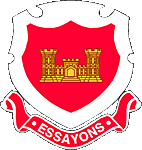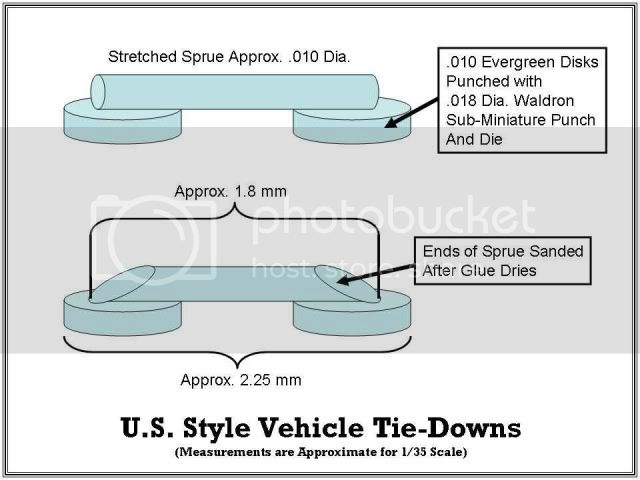Wow, I'm still laughing at myself...
Oh well, on to the tracks.
There's been some criticism of the Riich Universal Carrier tracks because of the way the sprue attachment points obscure the track pin head detail. This is a pretty fair observation, in my book.

Unfortunately, there're not a lot of options to replace the kit tracks. Model Kasten made a set of link-to-link, injection molded Universal Carrier tracks, but those are, AFAIK, out of production (though they can be found from time to time on eBay, etc). I think there are a couple of resin options, but I've never personally handled any to see the fidelity of detail, etc.
Fortunately, the Riich tracks will clean up nicely with a little work.
The first problem is how to get the tracks off of the sprues. For the double-link sections, I just used a pair of nippers. There's enough room between the sprue and parts. However, the longer sections are a bit more problematic.
I used a fine saw to cut my tracks off the sprues.


I deliberately left as much of the sprue at each attachment point to make it easier to get a good cut on them with my high-tech, super-fine, flush-cut nippers (i.e. finger nail clippers!)

I used the adjacent track pin heads to gauge the depth of these cuts, and on many of the sprue points, I could see the "ghost" of the underlying track pin heads, as well.
Next I used my sanding block to "gang" sand the sprue attachment points until I was just touching the adjacent track pin heads, removing their fine mold seams at the same time.

After the sanding block, I used my Flexi-file with a 600 grit tape to clean up sprue attachment points between the track links.

Finally, I gave the ends of the track links a couple of passes with 4x0 steel wool.

For assembling the tracks, I studied the kit parts very closely. I had hoped that the double-link track sections were all identical, but this is not the case.
By looking very carefully at how close the track guide horns were together on each pair, I identified at least three different configurations.
NOTE that I'm making a major deviation from the kit instructions here. I suggest that anyone building this kit make their own observations and decide for themselves the best sequence to assemble the tracks.So, I identified "narrow,' "medium" and "wide" track link pairs.
The "narrow" pairs mostly go around the idler wheel and drive sprocket. Here are the kit parts that I grouped together as "narrow" = 7, 8, 11, 13, 15, and 16, for a total of 38 "narrow" link pairs for both tracks.
The "medium" pairs are two transition links that terminate or begin a track run between wheels. I identified parts 9 and 17 as "medium" pairs, and there are a total of four, two on each side.
The "wide" pairs are the three double links over the return roller on each side, for a total of six "wide" pairs on both tracks. Their numbers are 2, 3, and 4.
So, as I assembled my tracks, I made no distinctions between the kit part numbers, just whether the track link pair was "narrow," "medium," or "wide."
This exercise made cutting these little links off the sprues and cleaning them up much easier, since I only had three groups of parts rather than 11 different groups.
I used the alignment jig described earlier to hold the tracks nice and straight as I glued them together. The longer sections must go where the kit instructions indicate. If the instructions are followed for these longer sections, there should be no issues with track direction. Both sides are identical and will assemble only one way.
I used tweezers to handle the small track link pairs and Testors liquid cement. After I glued the last links together, I allowed about another 10 minutes for the glue to set before I installed the tracks around the suspension.
I made a "cold" (un-glued) joint on the drive sprocket and trimmed the inside four track guide horns on the three links over the return roller so that the track will slip between the top of the roller and the bottom of the fender.
My tracks are assembled in single runs and will slip on and off for painting. The drive sprockets are not glued on the model yet. They must be trapped into the track before it's put onto the rest of the suspension, but with the cold-joint, the track can be opened and the drive sprocket removed for painting.





In these photos, the piece of blue tape is over the cold-joint holding the drive sprocket trapped in the track. The red "dots" on some of the track links are simply colored marker applied so that I could easily tell the ends of the various track sections for alignment on the suspension and wheels.
Here's a picture of the track removed from the left side.

Now, I have noticed the same thing that Terry Ashley remarked on in his review build - The tracks seem to be about one link too long. I have learned that styrene tracks do shrink a little along their length as they dry, so maybe by tomorrow, they will have tightened up a little.
If not, I will remove one link from one of the link-pairs around the idler wheels as that's where the slack appears on my build - around the idlers.
Frankly, I was dreading the tracks since I was anticipating a poor outcome when cleaning up the sprue attachment points. I was even prepared to sand all of the track pin head details off and replace them with .005 disks punched with a punch and die. However, now that I've cleaned them up, they're nicer than a lot of tracks, AM and kit, that I've used in the past.
They're not as nice and sharp as, say, DML's Magic Tracks, but they're at least as nice as the Spade Ace tracks I just used on my M13/40 build.
I'll make a quick up-date on the radio operator next.




























































































